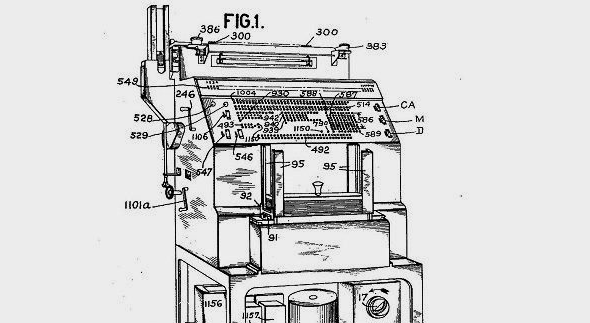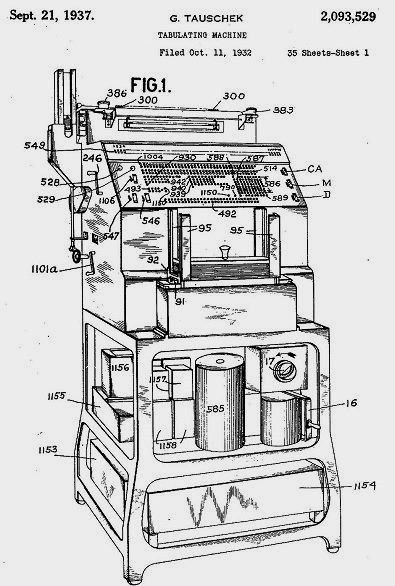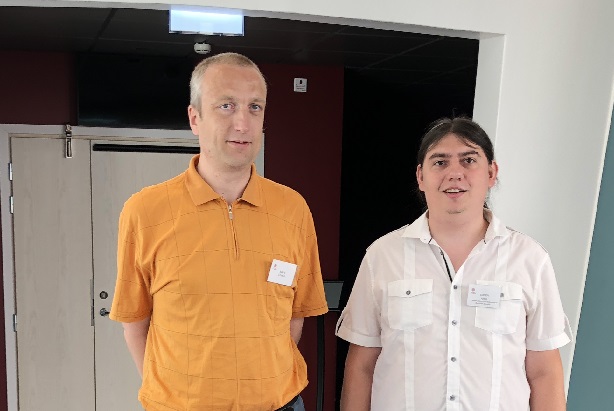The Tauschek encryption machine
Gustav Tauschek (1899-1945) was an ingenious inventor, but he was never able to turn his developments into commercial success. Blog reader Eugen Antal has found evidence that Tauschek also invented an encryption machine during World War II.
“He was probably the most imaginative mind in electromechanical data processing,” wrote the blog of the Heinz Nixdorf Museumsforum (HNF) a year ago, adding: “The bad news is that none of his concepts made it to market.”
We are talking about Gustav Tauschek, an Austrian pioneer in information technology who developed numerous improvements for the punch card-based calculators of the time between 1922 and 1945. The following picture shows a tabulator:
A picture of Tauschek (between engineer Engelbert Reingruber and physicist Josef Nagler in 1932) is available here.
Die Tauschek-Verschlüsselungsmaschine
Slovak crypto history expert Eugen Antal, …
…, who among other things runs the Portal of Historical Ciphers, recently brought an interesting thing to my attention. He came across references to an encryption machine built by Gustav Tauschek in the Slovak National Archives in Bratislava. Unfortunately, there is little information about this device. Perhaps my readers can help find out more.
Eugen has found three documents that mention the one Tauschek encryption machine. All three date from 1942, and it is not completely certain that “Tauschek” actually means the tinkerer in question. However, according to the said HNF article, he was supposed to have been in Slovakia during World War II. That would fit. Besides, a web page Eugen found says: “… he also invented an encryption machine, which operated on the mechanical basis and one which operated based on optical-electrical principle …” This also fits.
Unfortunately, for copyright reasons, I cannot present scans of the three documents in this article. However, since the documents are written in Slovak and do not contain pictures, this is not quite so dramatic. Thankfully, Eugen transcribed all three documents and translated the first one as well.
Document 1
The first document (July 24, 1942) is an instruction manual for a “Tauschek device”. It bears a stamp with an inscription that translates as: “MECHANIKA – Slovak Factory of Pressure Gauges and Thermometers Bratislava”.
Here is Eugene’s translation into English:
- Choose a password! As a precaution, it is better to create a password that consists of at least 6
letters, which do not form a meaningful word, e.g. UJSAKR. - Insert the pins into the bottom holes just below the letters of the selected password. Insert the pin
corresponding to the last letter of the password into the top hole below the appropriate letter. - Turn the pin corresponding to the first letter of the password with the pointer clockwise to the
stop of the lower half wheel. - Encryption: Find the first letter of the plaintext in the plain text alphabet (upper small disc) and
read the corresponding (opposite) letter from the lower larger disc (cipher alphabet). Turn the next
pin again to the stop and read the second letter of the text and continue in this way. If the upper pin
is turned to the stop, turn the next lower pin to the stop, and read the letter at that position. - Decryption : Set the machine to its original position, in such a way that under each letter of the
chosen password there is a pin in the lower holes and only for the last letter of the password is a pin
in the upper hole. Turn the pin of the first letter of the password to the stop and search for the
corresponding letter in the cipher text alphabet, and read the letter opposite in the plain text
alphabet. Continue in this way.
Important notes
If one pin is on top of the second, we must first turn the upper pin to the stop, then turn the lower
pin to the stop, and only then read the letter. The words can be separated by less frequently used letters like X. The word “ Stop” can be used instead of a full stop. Both letters and numbers can be selected for encryption. The process is the same.
Document 2
This document is a letter from the Ministry of Interior dated May 26, 1942, which mentions the ordering of a “Tauschek device.”
Encryption devices for the state police, order number: 21207/42 dated 15.IV.1942.
Attachments: 1 device and 1 offer.
Headquarters of the Police Directorate in Bratislava and one for the State Police Office in Žilina. After ordering and delivery, send the mentioned device to the named office opposite the confirmation. Have these devices consistently entered into the inventory. For the correctness of the execution.
Head of the presidency: Babčan v.r. Police Directorate in Bratislava
Document 3
This document comes from the police headquarters in Bratislava and is dated July 24, 1942. It could be a delivery bill for a “Tauschek device”.
- Encryption keys for the state Confidential! Police delivery.
- Mr. Police Director in Prešov,
- Mr. Head of the State Police Office in Žilina.
According to the attached depreciation of the decree of the Presidium of the Ministry of the Interior of 26 May 1942 no. 12-2070 / 2-1942 I am enclosed with:
- Bronze encryption key, “Tauschek” system, with leather case and with 15 pins, and
- Instructions for using the same encryption key.
At the same time, I request that the attached certificate be filled in, signed and returned so that I can comply with the 2nd and 3rd paragraphs of the cited decree of the Presidium of the Ministry of the Interior. The encryption key was purchased for the amount of 296.- Ks. The mentioned encryption key will be especially important in the planned construction of a police radiotelegraph network, for which the program for the determination of changeable secret encryption passwords will be issued by the Presidium of the Ministry of the Interior to all addressed authorities.
Police Director
What kind of encryption machine was the Tauschek device?
According to the three documents, the Tauschek device must have existed as a market-ready product (and not just as a prototype or design).
I would like to find out more about this device. Eugen Antal wrote me the following: “It looks like it is a polyalphabetic cipher machine. Based on the two cipher discs I guess it is something like the Kryha, where pins are used to arrange the plain text/cipher text alphabets based on a password. Without further information (details about the discs) it is hard to tell if the pins provide just a Caesar shift of the alphabet, or if the pins provide a shift on an already permuted alphabet. In my English translation I’ve used the cipher alphabet notation for the large disc, but in the original document it is as “rozhádzaná abeceda” what can be interpreted also as a ‘scattered alphabet’.”
Gustav Tauschek is said to have sold a total of 169 patents to IBM. In fact, you can find numerous patents by him on Google Patents, but none of them concern an encryption machine. The book United States Cryptographic Patents, 1861-1989 by Jack Levine also does not mention Tauschek.
There is a book titled Gustav Tauschek und seine Maschinen that is unfortunately out of print.
Can anyone say more about this machine? I would be glad about any hints.
If you want to add a comment, you need to add it to the German version here.
Follow @KlausSchmeh
Further reading: Virtueller Nachbau einer Verschlüsselungmaschine, die nie gebaut wurde
Linkedin: https://www.linkedin.com/groups/13501820
Facebook: https://www.facebook.com/groups/763282653806483/





Letzte Kommentare